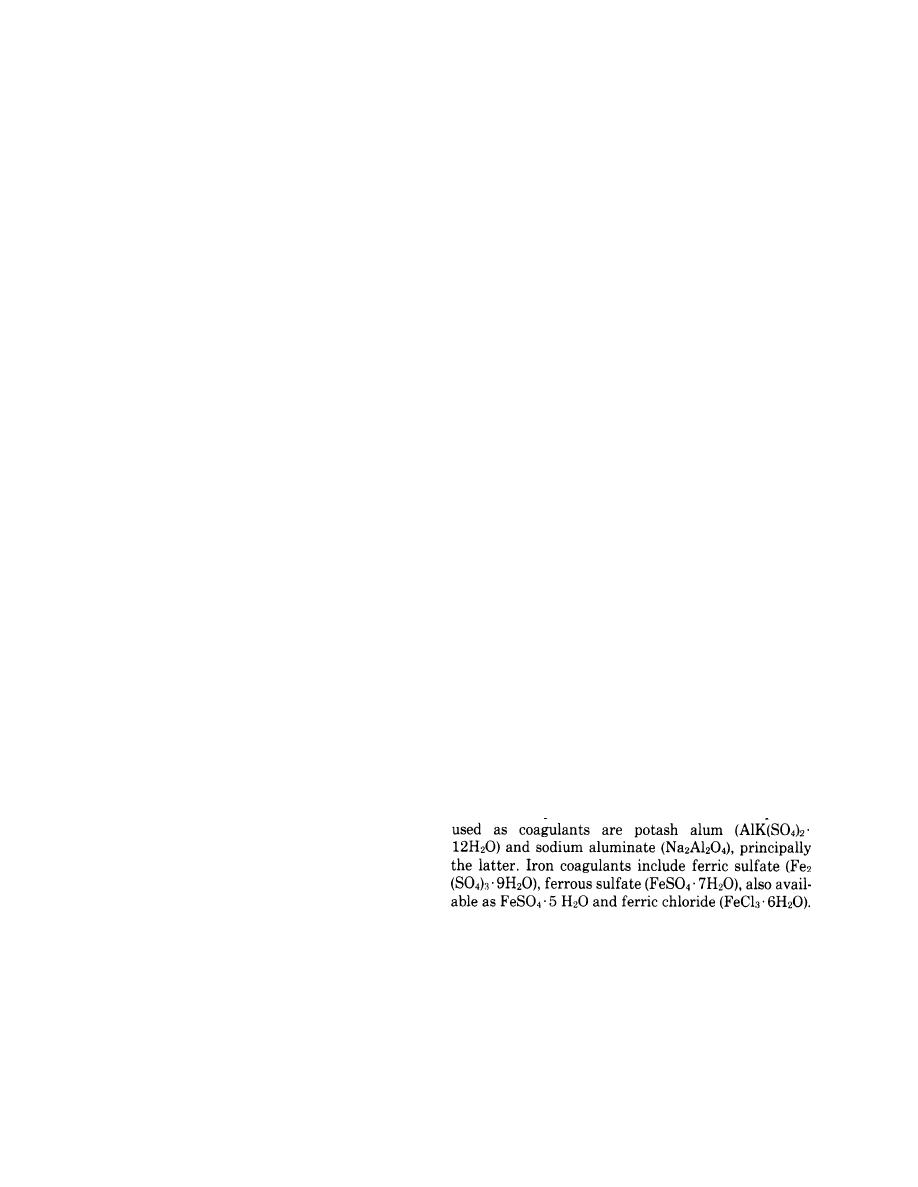
TM 5-813-3/AFM 88-10, Vol 3
waters contain higher levels of THM precursors than
mg/L) carbon dioxide concentrations, as encountered
groundwaters and therefore a need for aeration may
in some groundwaters, aeration for its removal is prob-
arise to reduce TTHM following chlorination. Water
ably justified. For concentrations on the order of 10
high in the bromine-containing THMs are difficult to
mg/L, or less, aeration is probably not economically
treat by aeration and other methods of removal should
valid. Before deciding to aerate for carbon dioxide re-
be used, such as coagulation and flocculation or con-
moval, the cost of purchasing, maintaining and operat-
ing the aerator should be compared to the value of the
tact with granular activated carbon.
lime saved. At softening plants, each mg/L of carbon
2-4. Coagulation and flocculation.
dioxide removed will effect a saving of about 1.3 mg/L
quicklime (95 percent calcium oxide). It will also re-
Coagulation and flocculation processes are defined as
follows: "Coagulation" means a reduction in the forces
duce the quantity of softening sludge produced propor-
which tend to keep suspended particles apart. The
tionately.
(3) Reduction of hydrogen sulfide. Aeration is also
joining together of small particles into larger, settle-
used for removing hydrogen sulfide from well water. It
able and filterable particles is "flocculation." Thus,
may be sufficient in itself if the hydrogen sulfide con-
coagulation precedes flocculation and the two process-
centration is not more than about 1.0 or 2,0 mg/L.
es must be considered conjunctively.
Otherwise, it maybe used in conjunction with chlorine
a. Purposes of coagulation and flocculation. Raw
water supplies especially surface water supplies, often
to oxidize the hydrogen sulfide not removed by aera-
tion.
contain a wide range of suspended matter, including
(4) Reduction of Volatile Organic Compounds
suspended minerals, clay, silt, organic debris and
(VOCs). Recent studies have shown that aeration can
microscopic organisms ranging in size from about
be successfully employed to reduce volatile organic
0.001 to 1.0 micrometer. Small particles in this size
compounds (VOCs) such as total Trihalomethane
range are often referred to as "colloidal" particles.
(TTHM) concentration in chlorinated water to meet
Larger particles, such as sand and silt, readily settle
current US EPA regulations limiting TTHM concen-
out of water during plain sedimentation, but the set-
trations. Aeration by diffused air or multiple-tray
tling rate of colloidal particles is so low that removal
aerators can reduce TTHM concentration at low cost,
of colloidal particles by plain sedimentation is not
with cost increasing with higher concentrations of Tri-
practicable. Chemical coagulation and flocculation
halomethane (THM). Counter-current packed tower
processes are required to aggregate these smaller par-
aeration is most efficient in achieving mass transfer of
ticles to form larger particles which will readily settle
VOC.
in sedimentation basins. The coagulation-flocculation
e. Aeration summary. Where icing is a problem and
processes are accomplished step-wise by short-time
the aerator must be housed, artificial ventilation by
rapid mixing to disperse the chemical coagulant fol-
fans or blowers is necessary. An enclosed induced- or
lowed by a longer period of slow mixing (flocculation)
positive-draft aerator requires approximately 3.5 to 6
to promote particle growth.
standard cubic feet of ventilating air per gallon of wa-
b. Chemical coagulant. The most frequently used
ter aerated. Thus, for an enclosed aerator operating at
chemical coagulant is aluminum sulfate (Al2
a rate of 1.5 mgd, air requirements will be in the range
(SO 4)3 14H 2O). This aluminum coagulant is also
of 3600-6200 standard cubic feet of air per minute.
called "alum" or "filter alum," and dissociates in water
for form S04 =, Al3+ ions and various aluminum hy-
Positive-draft aerators employing the higher air-flow
rates exhibit the highest efficiency for the addition
droxide complexes. Other aluminum compounds
and removal of dissolved gases and oxidation of iron,
manganese, and sulfide. Counter-current packed col-
umn aeration is particularly efficient to remove vola-
tile organic compounds, Requirements for a natural
draft, multiple-tray aerator having an overall height of
10 feet will be approximately 1,7 kilowatts per mgd of
Magnesium hydroxide (Mg(OH)2), is also an effective
aeration capacity, Power demands for forced draft
coagulant, Organic polyelectrolyte compounds, ap-
units will be greater. In general, aeration is worthy of
plied in low dosages alone or in combination with the
consideration in connection with the treatment of
metal coagulant, are also employed, Polyelectrolytes
groundwater supplies in conjunction with lime soften-
are high-molecular-weight polymers that dissociate in
ing and for the removal of some VOCs. Surface waters
water to give large highly charged ions, The polyelec-
usually exhibit low concentrations of carbon dioxide,
trolytes and dissociated ions destabilize the colloids
no hydrogen sulfide and fairly high dissolved oxygen.
and promote their settling, These polymers can be clas-
As a consequence, aeration is not required for the re-
sified an anionic, cationic or nonionic according to
moval or addition of these gases. However, surfaces
their dissociated polymeric ions being negatively
2-4


 Previous Page
Previous Page
